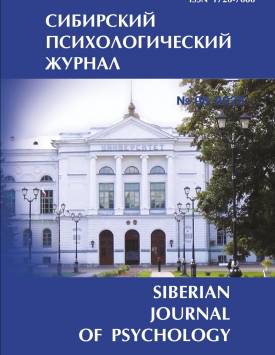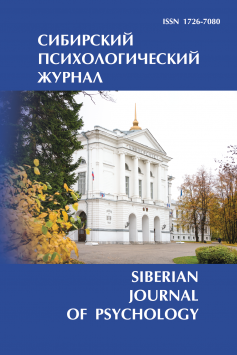Characteristics of Personal Anxiety in Elementary School Children from Russia, India and Kazakhstan: Cross-Cultural Aspect
International psychological and pedagogical research and their meta-analyses establish growth in high anxiety rates among current elementary school children, which makes it relevant to examine this problem in a comprehensive way, including in a poorly known cross-cultural aspect. The purpose of the article is a cross-cultural analysis of personal anxiety characteristics in ten-year-old elementary school children from urban comprehensive schools in Russia, India and Kazakhstan. In total, 900 children participated in the research, 300 elementary school children from each country with uniform gender distribution. A. M. Prikhozhan's “Personal Anxiety Scale” (Form “A” for school children aged 10-12) was used as a diagnostic tool. As a result of the research, universal and culture-specific characteristics of personal anxiety were established in elementary school children from Russia, India and Kazakhstan. Based on factor analysis, it was found that in all three child sample groups, the indicators of interpersonal and self-reported anxiety have the greatest weight, while the weight of school-based anxiety is less prominent, which can be explained by decisive influence of the age factor on the profile of personal anxiety of ten-year-old elementary school children from different countries. Statistically significant cross-cultural differences were revealed in average indicators of all types of personal anxiety (school-based, self-reported, interpersonal, magic, general) in elementary school children from three countries according to the Kruskal-Wallis H test. The lowest anxiety values, except for self-reported, are characteristic of ten-year-old school children from Kazakhstan, while all average anxiety indicators for these school children are concentrated in the normal level range. The average anxiety levels of Russian children are also within the normal range. The highest values for all types of anxiety, related to the “slightly higher” level, were demonstrated by elementary school children from India. Identical crosscultural differences were observed separately in sample groups of boys and girls. In the group of Indian children, statistically significant gender differences were also revealed for all types of anxiety except for interpersonal anxiety. In addition, cross-cultural differences were established in the choice made by children from different countries of those situations that cause the greatest anxiety on all anxiety scales. The results obtained can be useful for practice of psychological and pedagogical support of children.
Keywords
anxiety,
personal anxiety,
elementary school child,
cross-cultural analysis,
Russia,
India,
Kazakhstan,
culture-specific characteristicsAuthors
| Ivanova Natalia V. | Minin Nizhny Novgorod State Pedagogical University | ivanova30nv@yandex.ru |
| Suvorova Olga V. | Minin Nizhny Novgorod State Pedagogical University; Perm State Humanitarian Pedagogical University | olgavenn@yandex.ru |
| Shadrina Irina A. | Minin Nizhny Novgorod State Pedagogical University | rusakova.ir2019@yandex.ru |
| Sran Sarabjit K. | Mata Sundri College for women (University of Delhi) | sarabjeetkaur@ms.du.ac.in |
| Akpayeva Assel B. | Abai Kazakh National Pedagogical University | akpayeva@mail.ru |
Всего: 5
References
Агишева, А. А. (2023). Конструктивный потенциал тревожности и подхода: к его пониманию. Российский психологический журнал, 20(4), 42-62. doi: 10.21702/rpj.2023.4.3.
Амбалова, С. А. (2016). Проблема: и механизма: проявления тревожности учащихся младших классов. Балтийский гуманитарный журнал, 5(3), 86-89.
Бутабаева, Л. А., Длимбетова, Г. К., Исмагулова, С. К. (2023). Анализ эргономической доступности образовательного пространства в городских и сельских школах Казахстана. Вестник Евразийского национального университета им. Л.Н. Гумилева. Сер. Педагогика. Психология. Социология, 1(142), 46-54. doi: 10.32523/2616-6895-2023-142-1-46-54.
Дас, П. (2019). Неравенство возможностей в сфере образования в Индии: оценка индекса возможностей для человека по данным опросов. Вопросы образования, 4, 116132. doi: 10.17323/1814-9545-2019-4-116-132.
Донскова, Е. С. (2022). Взаимосвязь самооценки и уровня тревожности у детей младшего школьного возраста. Психология человека в образовании, 4(1), 41-52. doi: 10.33910/2686-9527-2022-4-1-41-52.
Егоренко, Т. А., Лобанова, А. В., Радчикова, Н. П. (2023). Диагностика трудностей в обучении в области социальной адаптации у младших школьников. Психологическая наука и образование, 28(5), 154-167. doi: 10.17759/pse.2023280512.
Имангалиева, Ш. Д., Бекжанова, Б. Ж., Ахметова, А. С. (2020). Бастауыш мектеп одушыларыныц сeздiк-логикалык ойлауы мен Yрейленуiн зерттеу мэселес [Проблемы изучения словесно-логического мышления и тревожности младших школьников]. Вестник КазНПУ им. Абая. Сер. Педагогические науки, 3(67), 144-151. doi: 10.51889/2020-3.1728-5496.19.
Казакова, Е. В., Соколова, Л. В. (2021). Сравнительный анализ эмоционального здоровья первоклассников при разных стилях семейного воспитания. Российский психологический журнал, 18(4), 18-29. doi: 10.21702/rpj.2021.4.2.
Карабанова, О. А. (2017). Детско-родительские отношения и практика воспитания в семье: кросс-культурный аспект. Современная зарубежная психология, 6(2), 15-26. doi: 10.17759/jmfp.2017060202.
Лебедева, Е. И. (2020). Современные предикторы школьной тревожности младших школьников. Вестник Ленинградского государственного университета им. А.С. Пушкина, 2, 347-359.
Микляева, А. В., Румянцева, П. В. (2004). Школьная тревожность: диагностика, профилактика, коррекция. СПб.: Речь.
Прихожан, А. М. (2000). Тревожность у детей и подростков: психологическая природа и возрастная динамика. М.: Моск. психол.-соц. ин-т; Воронеж: МОДЭК, 2000.
Руденко, M., Родич, M., Купер, E., Колиенко, T. В., Шарафиева, K. Р., Гынку, E. И., Ковас, Ю. В. (2013). Математическая тревожность, пространственные способности и математическая успешность: кросс-культурное исследование детей младшего 124 Особенности личностной тревожности у младшие школьников школьного возраста в России и Великобритании. Теоретическая и экспериментальная психология, 4, 18-25.
Рудомазина, В. М. (2016). Современная картина проявления тревожности у детей младшего школьного возраста. Психологическая наука и образование, 5(1), 76-85. doi: 10.17759/psyedu.2016080107.
Рязанцева, М. А., Мартышов, А. В. (2018). Выявление уровня тревожности у младших школьников столичного мегаполиса. Мир науки, культуры, образования, 1(68), 329-330.
Серебрякова, Т. А., Краева, И. В. (2024). Культура общения в системе «родитель-ребенок» как условие снижения тревожности у младших школьников. Вестник практической психологии образования, 21(4), 85-92. doi: 10.17759/bppe.2024210408.
Тихомирова, Т. Н., Малых, С. Б. (2023). Половые различия в успешности школьного обучения математике и русскому языку: кросскультурное исследование. Сибирский психологический журнал, 87, 104-123. doi: 10.17223/17267080/87/6.
Чернышова, Е. Л., Иванов, Д. В. (2016). Особенности личностной самооценки и тревожности младших школьников цыганского и русского этносов. Азимут научных исследований: педагогика и психология, 5(4), 346-349.
Шерайзина, Р. М. Ефлова З. Б. (2021). Сельская школа современной России и зарубежья. Непрерывное образование:XXIвек, 1(33). doi: 10.15393/J5.art.2021.6685.
Aydin, U. (2019). Test anxiety: Gender differences in elementary school students. European Journal of Educational Research, S(1), 21-30. doi: 10.12973/eu-jer.8.1.21.
Bartosh, O. P, Bartosh, T. P, & Mychko, M. V. (2021) Features of anxiety and attention in elementary school students of the Russian North.Russian Open Medical Journal, 10(3). doi: 10.15275/rusomj.2021.0314.
Bieg, M., Goetz, T., & Lipnevich, A. A. (2014) What Students Think They Feel Differs from What They Really Feel - Academic Self-Concept Moderates the Discrepancy between Students’ Trait and State Emotional Self-Reports. PLoS ONE, 9(3). doi: 10.1371/journal.pone.0092563.
Bodas, J., OUendick, T. H., & Sovani, A. V. (2008). Test anxiety in Indian children: A cross-cultural perspective. Anxiety, Stress, & Coping, 21(4), 387-404. doi: 10.1080/10615800701849902.
Carey, E., Devine, A., Hill, F., & Szucs, D. (2017) Differentiating anxiety forms and their role in academic performance from primary to secondary school. PLoS ONE, 12(3). doi: 10.1371/journal.pone.0174418.
Deb, S., Chatterjee, P., & Walsh, K. (2010) Anxiety among high school students in India: Comparisons across gender, school type, social strata and perceptions of quality time with parents. Australian Journal of Educational and Developmental Psychology, 10, 18-31.
Du, Y. Z., Kao, T. F., Fang, B. J., Shen, Y. C., & Cai, Q. Y. (2023, July). Study on the Situation, Prevention and Strategy of Learning Anxiety in Primary School Students. Proceedings of the 2023 2nd International Conference on Educational Innovation and Multimedia Technology (EIMT 2023), 1076-1082. doi: 10.2991/978-94-6463-192-0_140.
Essau, C. A., Anastassiou-Hadjicharalambous, X., Demetriou, C., & Pourseied, K. (2012). Cultural Factors and Anxiety in Children and Adolescents: Implications for Treatment. In C. A. Essau, & T. H. Ollendick (Eds), The Wiley-Blackwell Handbook of The Treatment of Childhood and Adolescent Anxiety (pp. 157-175). New York: John Wiley and Sons.
Fu, J. N., Yu, W. B., Li, S. Q., & Sun, W. Z. (2024). A bibliometric analysis of anxiety and depression among primary school students. Frontiers in Psychiatry, 15. doi: 10.3389/fpsyt.2024.1431215.
Hanie, E. H., & Stanard, R. P. (2009) Students with Anxiety: The Role of the Professional School Counselor. Georgia School Counselors Association Journal, 16(1), 49-55.
Headley, C., & Campbell, М. (2011). Teachers’ Recognition and Referral of Anxiety Disorders in Primary School Children. Australian Journal of Educational & Developmental Psychology, 11, 78-90.
Hill, F., Mammarella, I. C., Devine, A., Caviola, S., Passolunghi, M. C., & Szucs, D. (2016). Maths anxiety in primary and secondary school students: Gender differences, developmental changes and anxiety specificity. Learning and Individual Differences, 48, 45-53. doi: 10.1016/j.lindif.2016.02.006.
Hinchliffe, K., & Campbell, M. (2016). Tipping Points: Teachers’ Reported Reasons for Referring Primary School Children for Excessive Anxiety. Journal of Psychologists and Counsellors in Schools, 26(1), 84-99. DOI: 10.1017 / jgc.2015.24.
Hofstede, G. (2011). Dimensionalizing Cultures: The Hofstede Model in Context. Online Readings in Psychology and Culture, 2(1). doi: 10.9707/2307-0919.1014.
Ivanova, N., & Sorokina, T. (2020). Educational environment approach to preventing the growth of school students anxiety in the transition from primary to secondary school. Elementary Education Online, 19(1). 333-342. doi: 10.17051/ilkonline.2020.661841.
Maloney, E. A., Ramirez, G., Gunderson, E. A., Levine, S. C., & Beilock, S. L. (2015).Intergenerational Effects of Parents' Math Anxiety on Children's Math Achievement and Anxiety. Psychological Science, 26(9). doi: 10.1177/0956797615592630.
Manley, H., Tu, E.-N., Reardon, T., & Creswell, C. (2023). The relationship between teachers' day-to-day classroom management practices and anxiety in primary school children: A systematic review. Review of Education, 11. doi: 10.1002/rev3.3385.
Putwain, D. W., Stockinger, K., Embse, N., Suldo, S., & Daumiller, M. (2021). Test anxiety, anxiety disorders, and school-related wellbeing: Manifestations of the same or different constructs? Journal of School Psychology, 88(2), 47-67. doi: 10.1016/j.jsp.2021.08.001.
Rathod, R., & Chauhan, D. (2023). Academic Anxiety among Primary School Students. Journal of General Education and Humanities, 2(3). 177-186. doi: 10.58421/gehu.v2i3.91.
Sherayzina, R. M. & Eflova, Z. B. (2021). Sel'skaya shkola sovremennoy Rossii i zarubezh'ya [Rural School in Modern Russia and Abroad]. Nepreryvnoe obrazovanie:XXIvek, 1(33). doi: 10.15393/j5.art.2021.6685.

